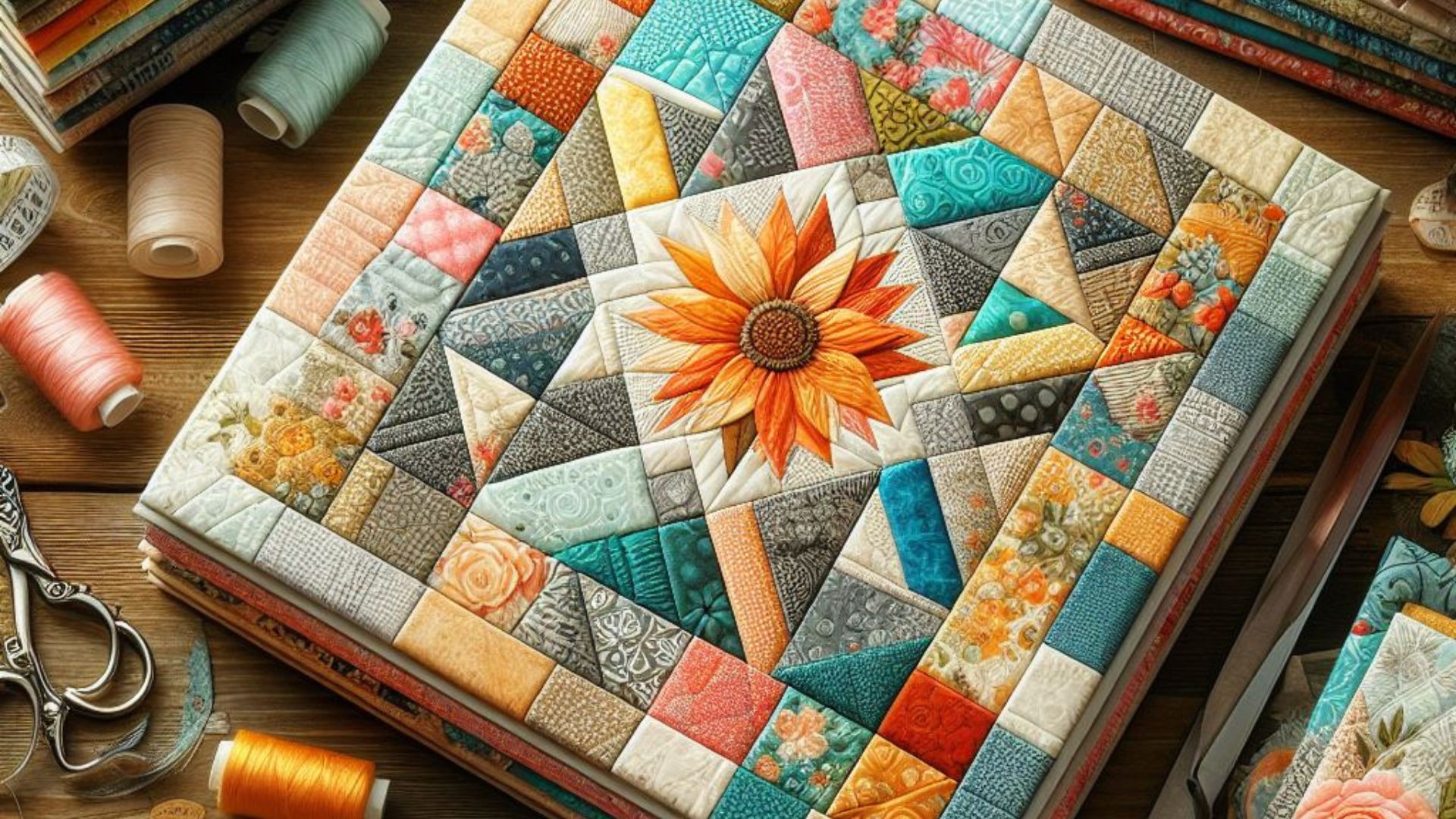Choosing a quilt pattern can be an exciting yet daunting task, especially with the vast array of beautiful designs available.
Let’s delve into some steps that can guide you through this creative journey!
Understanding Your Skill Level
Beginner-Friendly Patterns
If you’re new to quilting, consider simpler patterns like the classic Patchwork or Rail Fence. These designs involve straight cuts and basic seams, perfect for beginners.
Intermediate and Advanced Patterns
For those with more experience, explore patterns with intricate blocks, like the Log Cabin or Dresden Plate. These may involve more complex techniques such as appliqué or curved piecing.
Considering Quilt Size and Use
Bed Quilts
If you’re making a quilt for a bed, the pattern should match the bed size. King, queen, double, twin – each size might require different block sizes or layouts.
Wall Hangings or Decorative Quilts
For decorative purposes or wall hangings, smaller patterns like mini quilts or art quilts can be more manageable and offer room for creative experimentation.

Theme and Style
Traditional or Modern Designs
Think about your preferred aesthetic. Traditional designs like the Ohio Star or Flying Geese evoke a classic feel, while modern designs like improvisational quilting or geometric patterns bring a contemporary touch.
Personalization
Consider who the quilt is for. Are you creating it for a specific person or occasion? Tailor the pattern to their preferences or the intended use.
Gathering Inspiration and Resources
Online Resources and Communities
Browse quilting websites, forums, and social media platforms like Pinterest or Instagram for inspiration. You might find tutorials, pattern guides, or even free quilt-along events.
Books and Magazines
Explore quilting books and magazines for a wealth of pattern options and detailed instructions. Sometimes, visual guides in print can offer a clearer understanding of a pattern.
More Tips
Test with Fabric Scraps
Before committing to a pattern, experiment with fabric scraps. This helps visualize how the pattern looks with your chosen fabrics and ensures coherence in color and design.
Start Small
If unsure, begin with a smaller project or a block from the intended pattern. This allows you to gauge the difficulty level and decide if it aligns with your skills and preferences.
Choosing a quilt pattern is a delightful adventure that allows your creativity to shine. Remember, there’s no right or wrong pattern – it’s about finding one that speaks to you and brings joy in the making process.
External Resources:
Moving forward
Diving deeper into the world of quilt patterns, let’s explore more factors and considerations to help you find the perfect pattern that resonates with your style and skill level.
Exploring Pattern Varieties
Block-Based Patterns
Patterns based on blocks offer versatility. You can mix and match blocks, change their layout, or adjust colors to create unique designs. Classic blocks like the Nine Patch or the Friendship Star are timeless choices.
Appliqué Patterns
Appliqué involves sewing fabric shapes onto a background fabric to create designs. Consider patterns like the Baltimore Album or Hawaiian quilts for beautiful appliqué work.
Foundation Paper Piecing
For precision and intricate designs, explore foundation paper piecing patterns. These patterns use a paper template to guide fabric placement, resulting in detailed and accurate designs like Mariner’s Compass or intricate animal shapes.
Assessing Complexity and Time Commitment
Complexity Level
Evaluate the complexity of the pattern. Some patterns require intricate piecing or appliqué techniques, while others may involve curved piecing or Y-seams, which could be more challenging.
Time Commitment
Consider the time you’re willing to invest. Some patterns might be quick and straightforward, while others with intricate details could be time-consuming.
Mixing and Matching Patterns
Pattern Combinations
Get creative by combining multiple patterns. Use a main pattern for the quilt center and complement it with border patterns or alternate blocks for added visual interest.
Design Software
Utilize quilt design software or apps to visualize pattern combinations and color schemes. These tools allow you to experiment virtually before cutting into fabrics.
Adapting Patterns to Your Preference
Size Alterations
Don’t hesitate to adjust the size of the quilt blocks or the overall pattern to fit your desired dimensions. This flexibility allows customization based on your needs.
Color and Fabric Selection
Experiment with various color palettes and fabric combinations. The same pattern can evoke different moods or aesthetics based on fabric choices.
Seeking Guidance and Learning Opportunities
Workshops and Classes
Consider attending quilting workshops or online classes. Expert guidance can help demystify complex patterns and provide hands-on learning experiences.
Local Quilting Guilds or Groups
Engage with local quilting guilds or groups. Sharing experiences and seeking advice from seasoned quilters can offer invaluable insights and recommendations.
Final Considerations
Enjoy the Process
Above all, enjoy the process! Quilting is a labor of love, and each step – from choosing a pattern to piecing it together – is an opportunity for creativity and self-expression.
Choosing a quilt pattern is a personal journey that aligns your skills, preferences, and creativity. It’s about finding joy in the art of quilting while creating something beautiful and meaningful.
External Resources:
Comparison tabular
| Pattern Type | Description | Skill Level | Time Commitment | Example Patterns |
|---|---|---|---|---|
| Block-Based Patterns | Versatile designs made of repeating blocks | Beginner to Expert | Moderate to High | Nine Patch, Friendship Star |
| Appliqué Patterns | Involves sewing fabric shapes onto a background fabric | Intermediate | Moderate | Baltimore Album, Hawaiian quilts |
| Foundation Paper Piecing | Precise and intricate designs using paper templates | Intermediate to Expert | High | Mariner’s Compass, Animal shapes |
| Consideration | Details |
|---|---|
| Complexity Level | Block-based patterns vary in complexity based on block intricacy. Appliqué and paper piecing might involve more intricate techniques. |
| Time Commitment | Block-based patterns might be quicker; however, intricate details or paper piecing could require more time. |
| Mixing Patterns | Block-based patterns allow easy mixing for different layouts. Appliqué and paper piecing might need adjustments for combination. |
| Adaptability | Options |
|---|---|
| Size Alterations | Block-based patterns allow resizing with simpler adjustments. Appliqué and paper piecing might need more planning for resizing. |
| Color and Fabric | All patterns offer opportunities for color and fabric experimentation. The impact might vary based on complexity. |
| Learning Resources | Avenues |
|---|---|
| Workshops and Classes | Beneficial for learning new techniques, especially for complex patterns like appliqué or paper piecing. |
| Quilting Guilds/Groups | Provide a supportive environment for sharing experiences and seeking advice for any pattern type. |
This table gives a snapshot view of the various types of quilt patterns, considering skill levels, time commitments, adaptability, and learning opportunities. Each pattern type offers unique features, catering to different preferences and skill levels within the quilting community.
Creating a quilt involves a blend of creativity, skill, and personal preference. Consider these aspects as guidelines while selecting the pattern that resonates most with your style and skill set.
Wrapping up
Choosing a quilt pattern is like selecting the first stroke on a canvas; it sets the tone for your artistic journey. Whether you’re a novice or an experienced quilter, the process of choosing a pattern should be guided by your passion, skill level, and creative vision.
Remember, there’s no one-size-fits-all when it comes to quilt patterns. Each pattern holds its own charm and challenges, offering an opportunity for artistic expression. Embrace the journey, enjoy the process, and let your imagination flourish as you stitch together your masterpiece.
Explore, experiment, and most importantly, have fun with your quilting adventure. Whether it’s the simplicity of a classic block or the intricacy of an appliqué masterpiece, the joy of quilting lies in the journey of creation.

For over a decade, I’ve been Mike, an artist, crafter, and designer deeply immersed in the Croc world. I thrive on crafting unique, size-inclusive patterns, fostering creativity, and sharing them on ktforum.com. My designs aim to ignite your creative spark and delight you, ensuring clarity and ease of use through rigorous testing. Join me in expressing your creative flair and showcasing your craft with joy.
Related Posts
- The Beginner's Guide to Easy Quilt Patterns
Quilting is an art that weaves together creativity, fabric, and patience to create beautiful, functional…
- Creating a Quilt: A Timeless Craft
Quilting, a cherished craft passed down through generations, invites both beginners and seasoned artisans into…
- Quilting: Rows vs. Sections
Quilting, an artful fusion of fabric and stitching, often presents the delightful conundrum of choosing…
- Preventing Bunching in Your Quilt While Quilting: Top Tips and Tricks
Quilting is an art form that stitches together creativity, comfort, and craftsmanship. However, if your…

